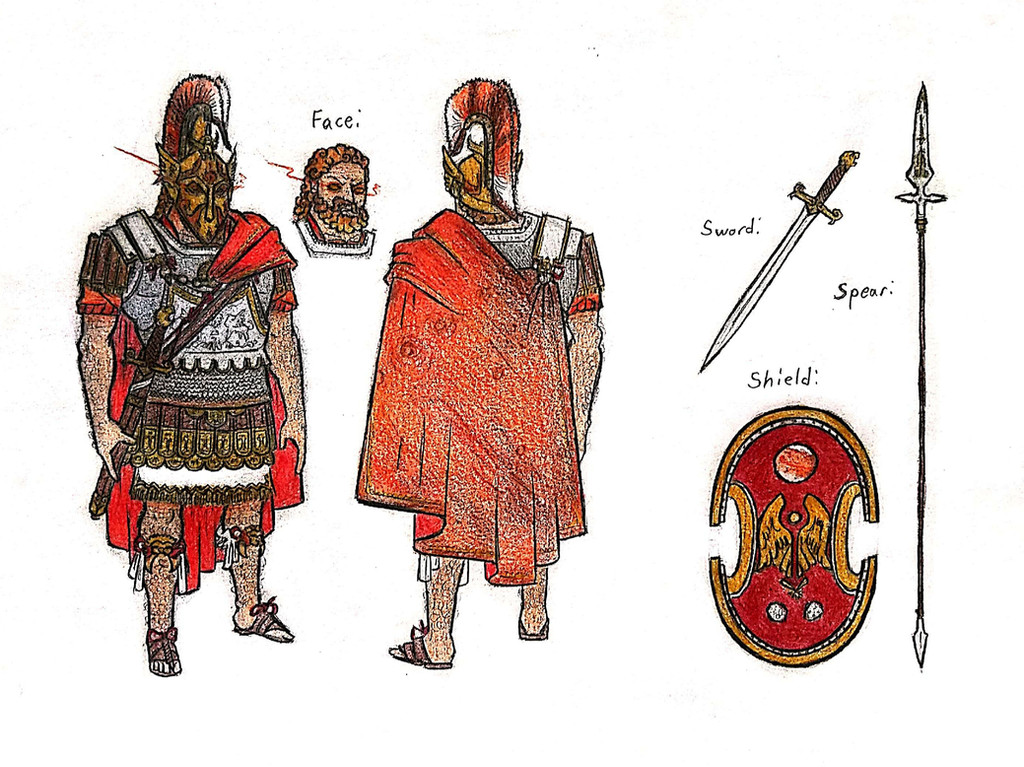HOME | DD
 Avapithecus — Ares
Avapithecus — Ares

#ares #character #design #god #greek #mars #mythology #referencesheet #roman #war
Published: 2023-07-18 17:13:10 +0000 UTC; Views: 5690; Favourites: 71; Downloads: 0
Redirect to original
Description
Ares (called Mars by the Romans) was the ancient Greek god of war (you know before Kratos came and took his title), or at least the god of relentlessly slaughtering your fellow man. His sister Athena, goddess of war, had her domain in the actual stratagem of conflict. But Ares says that's lame and boring, and probably doesn't care for nerd shit like literary history. Unfortunately, this is my page, so that's what we're gonna jump into anyways. Ares first shows up in Linear B tablets dating to the Mycenaean period, rendered as "a-re", which seems to be cognate to the classic Greek "ara/are" meaning "bane", "ruin", or "curse". It certainly highlights the incredibly violent and destructive characterization Ares would come to assume. While the Homeric Hymns attest him as the father of the more charitable Nike (goddess ot victory), he is elsewhere described as bringing to the battlefield his sister, Eris (goddess of strife and chaos), and his two sons Phobos and Deimos (fear and dread). This doesn't necessarily make Ares an antagonist in our modern sense of the word, but he certainly has no reputation to stand on. His own family among the Olympians despises him. One short story barely recorded in the Iliad describes an episode where Ares is kidnapped and stuffed in a jar by two giants attempting to raid Mount Olympus for some of that sweet sweet goddess ass. The gods preceed to do absolutely nothing for a whole year before finally mounting a rescue when the giants' stepmother reminds them that hey, they like… still have your son, maybe you should like… do something about that? Just a suggestion.Ares otherwise appears in very few myths as a main character. He only really gets his cameo quota in when his relationship to the goddess of love, Aphrodite, is brought up. This is most famously exemplified in an episode of the Odyssey, wherein Ares and Aphrodite thoroughly cuck her actual husband Hephaestus, the other black sheep of the family. If Ares is the roided jock who has more testicles than he has brain cells, Hephaestus is the wimpy nerd of the family, and it's pretty clear that the original mean girl Aphrodite wants absolutely nothing to do with this loser. Hephaestus, however, gets tipped off by Helios that Ares has been sneaking into his own house to bang his wife, and concocts a plan to literally catch them in the act. Using his magical forge, he creates a net so fine that it's nearly invisible, and rigs it to a trap over his bed. When Ares and Aphrodite come tumbling in, Hephaestus springs the trap, gets them stuck in the net, invites all the Olympians in to chastise their infidelity… and then all the gods instead proceed to make fun of Hephaestus for being a beta male cuck. Hephaestus grumpily refuses to let the couple go until Zeus pays him back his wedding dowry. Or anyone, literally anyone. He just wants his refund, dammit. Nothing further is said of this incident, so I can only assume that Ares continued to plow that most sacred ass without anyone to stop him. I'm certainly not going to, are you?
This dynamic is sort of reflected in archaeology as well, interestingly enough. Sparta is an excellent case study for this. While popular media may lead us to imagine that Ares was the patron god of the infamously militaristic city-state, there's actually little to no shrines dedicated to Ares in Sparta at all. The most I could find was a brief passage from the geographer Pausanias, who mentions that the Spartans had a statue of Ares chained up outside the Temple of Hipposthenes so that war will never be able to escape the Spartans. Pausanias seems to be the only source of this detail, however, and it might not even be Ares at all. Pausanias uses the name "Enyalius", which is an archaic epithet for Ares, but by Pausanias's time came to be understood as a separate god who was Ares's son. He does describe the statue as "old", so it's possible the original builders meant it to be Ares, but Pausanias never gives an exact date, and the statue has since been lost to time, so we'll probably never know. Conversely, it actually seems that Aphrodite was the major patron god of Sparta, being widely worshipped in the form of Aphrodite Areia, the "Ruinous Aphrodite". This may seem contradictory at first glance but it actually harkens back to Aphrodite's origins in the Canaanite war goddess Astarte. And let's be honest, there's a very, very thin line between love and war. I generally don't like to insert allegory where there isn't explicitly said to be, but the writer in me can't deny all the juicy metaphors you can extract from the relationship between Aphrodite and Ares, between the beating heart and the thundering drums.
The Romans gave their Mars a little extra spotlight as the father of their founders, Romulus and Remus, through his very icky nonconsensual visit to Rhea Silvia. The Roman Mars is probably not directly cognate with the Greek Ares, he simply came to be identified as such. Mars seems to have gotten his start as a god of the agricultural aspect of war (after all, an army marches on its stomach). I've seen varying accounts, all equally vague, on the exact origins of Mars beyond the Romans. The name is either linked to the Latin "maris" meaning "men", which would make Mars something like "the Manly One" (and giving rise to our modern English "martial"), or he has some extremely obscure link to the Etruscan god Maris. As I understand it, Maris is an extremely obscure figure in himself, and isn't really a war god (that title goes to the god Laran), so if there is actually any relation between him and Mars, the mechanism is completely unclear. That's a whole can of worms that's beyond the scope of this blurb about the Greek god specifically, so once I've done more thorough research, I may end up doing a whole separate blurb for Mars for another day.
Design notes, there seem to be two schools of thought when the ancients created iconography for Ares. The Romans, when they depicted Mars, favored the approach of decking him out in the most resplendent armor, worthy of any high-level video game loot. The classical Greeks, meanwhile, preferred to draw him as a buck naked jock with a helmet, as if that's the part that Ares needs protecting. Obviously I leaned into the Roman side of things. His outfit is pretty much taken entirely from "Mars and Rhea Silvia", a 1617 painting by Peter Paul Rubens. That breastplate is just sick as hell. I also included the cape structure from a 1771 painting by David Jacques-Louis titled "The Combat of Mars and Minerva", and threw on the pteruges featured on the statue of Mars from the Forum of Nerva. His helmet and equipment I mostly designed whole cloth. I'm not entirely sure I'm happy with them, but they suffice. Honestly my biggest gripe is with the proportions. Male anatomy proves to be my ruin yet again, fittingly. I tried to make him this big burly barbarian, but the shoulders and arms are kind of off and he just sort of looks weird. This is probably one I'll revisit in the future for some minor tweaks.
Related content
Comments: 3

👍: 1 ⏩: 0

👍: 1 ⏩: 1

👍: 0 ⏩: 0






















